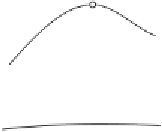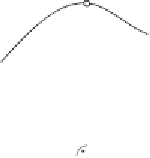Geoscience Reference
In-Depth Information
taken into account according to Sect. 8.2. To apply the above formulas, either
Φ and Λ must be reduced down to the geoid or
ξ
and
η
must be reduced up
to the ground. In both cases this involves the reduction for the curvature of
the plumb line (Sect. 5.15), which also depends on the mean value
g
through
its horizontal derivatives. Hence Prey's reduction enters here too.
Thus we see that in the conventional approach to the problems of physical
geodesy we must know the density of the outer masses or make assumptions
concerning it. To avoid this, Molodensky proposed a different approach in
1945.
Figure 8.2 shows the geometrical principles of this method, which is es-
sentially a linearization of Eq. (8-10). The ground point
P
(i.e., point on the
earth's surface
S
) is again projected onto the ellipsoid according to Helmert.
However, the ellipsoidal height
h
is now determined by
h
=
H
∗
+
ζ,
(8-18)
the
normal height H
∗
replacing the orthometric height
H
,andthe
height
anomaly ζ
replacing the geoidal undulation
N
.
This will be clear if one considers the surface whose normal potential
U
at
every point
Q
is equal to the actual potential
W
at the corresponding point
P
,sothat
U
Q
=
W
P
, corresponding points
P
and
Q
being situated on the
same ellipsoidal normal. This surface is called the
telluroid
(Hirvonen 1960,
1961). The vertical distance from the ellipsoid to the telluroid is the normal
height
H
∗
(Sect. 4.4), whereas the ellipsoidal height
h
is the vertical distance
from the ellipsoid to the earth's surface. Thus, the difference between these
two heights is the height anomaly
H
∗
,
ζ
=
h
−
(8-19)
closely corresponding to the geoidal undulation
N
=
h
H
,whichisthe
difference between the ellipsoidal and the orthometric height.
−
P
³
earth's
surface S
Q
telluroid
h
H
*
ellipsoid E
Q
0
Fig. 8.2. Telluroid, normal height
H
∗
, and height anomaly
ζ





